11 Best Native Plants for Columbia, SC
BY FARAH NAUMAN | MARCH 27TH, 2023 | COLUMBIA, LAWN CARE, SOUTH CAROLINAOur balmy climate and Southern charm are what defines the Carolinas. And although it’s pretty hot for a good part of the year, Columbia has an abundance of ecoregions that support a wide array of plants.
The heat may discourage many homeowners from building a nice, big garden, but that won’t be a problem if you plant natives that have adapted to Columbia’s hot weather. To help you with that, we put together a list of nine of the best native plants for Columbia to help you brighten up that dull yard.
In this article:
- Why Are Native Plants Better?
- 11 Best Native Plants for Columbia, South Carolina
- How to Choose the Best Plants for Your Columbia Landscape
- Where to find native plants in Columbia
What Are Native Plants and Why Are They Better?
A native plant is a species that has lived, reproduced, and adapted naturally in a specific region or area for hundreds or even thousands of years. Their presence then becomes an integral part of that area’s ecosystem.
These natives adapt perfectly and completely to the region’s soil conditions, climate, temperature, light exposure, and other factors of the environment until they become part of it. That makes them “indigenous”.
Want a healthy, long-lasting, and beautiful yard? Native plants are the way to go. There are many advantages of planting natives in your landscape, including:
- They’re pretty low-maintenance since they’re well acquainted with the soil conditions, soil pH, light, temperature, and moisture in the Columbia climate.
- Native plants attract lots of beneficial pollinators, birds, and other wildlife to your garden.
- They are stronger and healthier – meaning less disease, fewer pesticides, and low fertilizer needs.
- These plants help make the environment safer. They use fewer fertilizers and pesticides, reducing damage to the ecosystem and minimizing the chances of chemical pollutants contaminating water bodies.
- Natives help conserve water since they’re adapted to local conditions and need far less supplemental watering. This saves time, resources, money, and plenty of natural resources.
- There’s a wide variety of natives that thrive in Columbia and will create a beautiful lawn.
11 Native Plants for Your Columbia Yard
Here is a collection of the best natives you can bring into your Columbia lawn and enjoy a low-maintenance landscape.
1. Carolina Phlox (Phlox carolina)
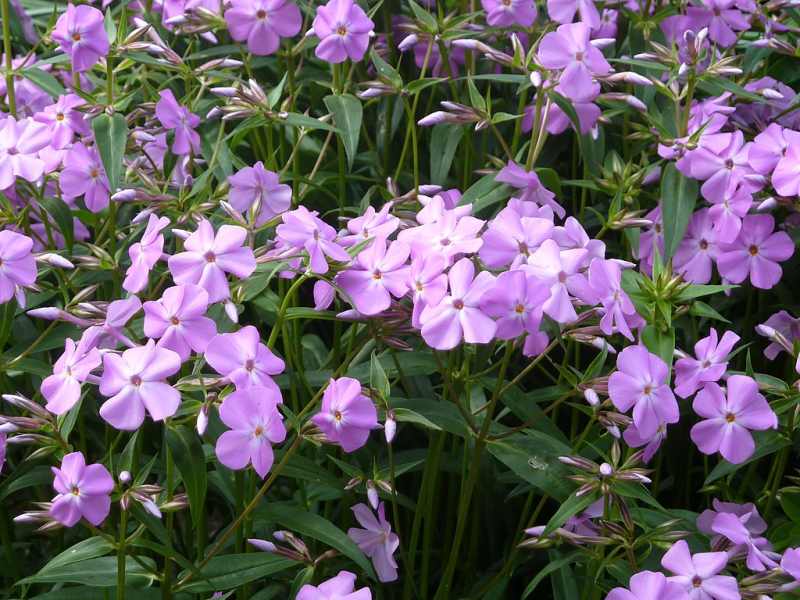
Photo Credit: peganum from Small Dole, England / Wikimedia Commons / CC BY-SA 2.0
The strongest Southeastern U.S. native plant, Carolina phlox is a herbaceous flowering plant that boasts broadly cylindrical clusters of white, pink, or lavender flowers. They bloom from late spring to mid-summer and continue intermittently until the first few touches of frost.
Carolina phlox flowers sit atop red-streaked, slender stems with oval, leathery leaves that bear the perfect bright-green color. Clusters of these nectar-rich flowers attract bees, hummingbirds, and a wide variety of butterflies to your garden. Fresh, picture-perfect Carolina phlox flowers make excellent fresh-cut flowers too!
This native plant self-sows but won’t get aggressive. It works great in perennial borders, home gardens, and city gardens.
Plant type: Flower
Mature size: 2 to 3 feet tall
Duration: Perennial
Sunlight needs: Full sun, but capable of tolerating shade
Soil preferences: Acidic or neutral clay, loamy, sandy soils
Water needs: Low, tolerant of dry conditions
USDA hardiness zone: 5a – 9b
2. Black Cohosh (Actaea racemosa)
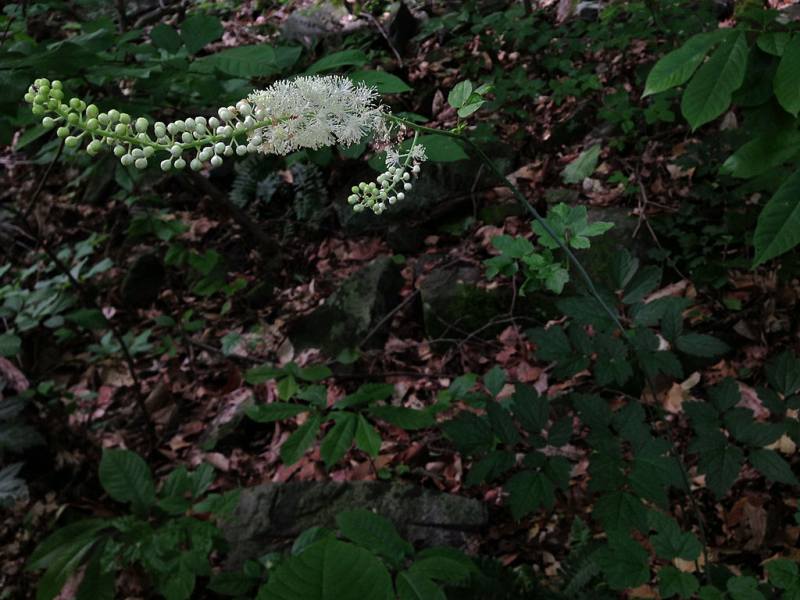
Photo Credit: Fritzflohrreynolds / Wikimedia Commons / CC BY-SA 3.0
Also known as black bugbane, the black cohosh plant is native to most of eastern North America. It is a woody perennial that thrives in shady forest edges and grows into tall flower spikes bearing pom-pom-like flowers. This native plant strikes with its arching wands of white flowers all summer long and has finely divided, deep green foliage that compliments the flowers well.
The fluffy spikes grow into seed pods and make a great addition for shade gardens. Black cohosh prefers moist, rich soil with organic matter and thrives in partial shade to full shade, making it one of the easiest, low-maintenance plants for a Columbia lawn.
Plant type: Flower
Mature size: 2 to 5 feet tall
Duration: Perennial
Sunlight needs: Partial shade
Soil preferences: Slightly acidic and rich loam
Water needs: Medium
USDA hardiness zone: 3a – 8b
3. Oakleaf Hydrangea (Hydrangea quercifolia)
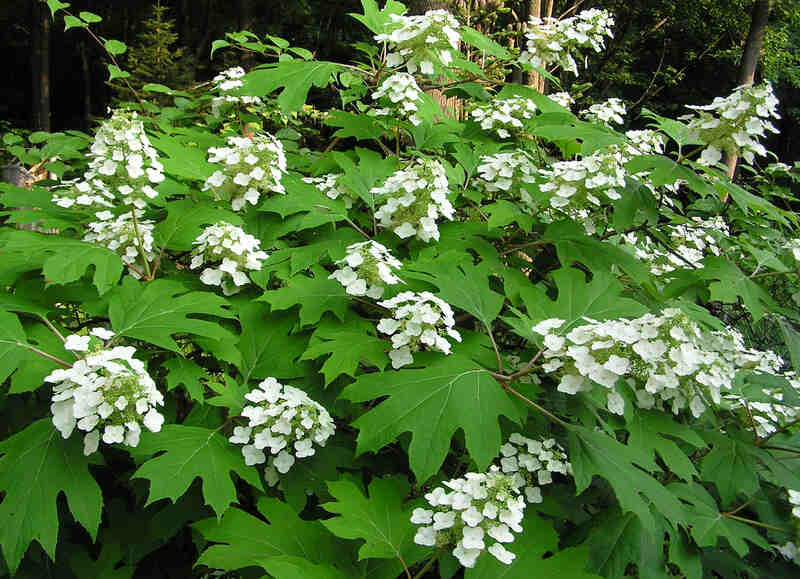
Photo Credit: normanack / Flickr / CC BY 2.0
This is a colorful native shrub that will fill your garden with shades of green, white, pink, and burgundy all around the year. Oakleaf hydrangea develops into a large woody shrub and has tiny flowers that form clusters at each branch end. It produces white blooms that arrange themselves in showy, pyramidal clusters.
Below the flowers are large dark green leaves that add to the plant’s grandeur. The blooms give a honey-like scent, attracting tons of bees to your yard.
It prefers well-drained and organically rich soils with medium moisture content and does well with full sun to partial shade. Oakleaf hydrangea is a long-living perennial that blooms from mid-summer to early summer. As summer progresses the white bracts turn pink and make beautiful dried flower arrangements.
Plant type: Shrub
Mature size: 4 to 8 feet tall
Duration: Perennial
Sunlight needs: Full sun to partial shade
Soil preferences: Well-draining soil with high organic matter
Water needs: Medium
USDA hardiness zone: 5a – 9b
4. Crested Iris (Iris cristata)
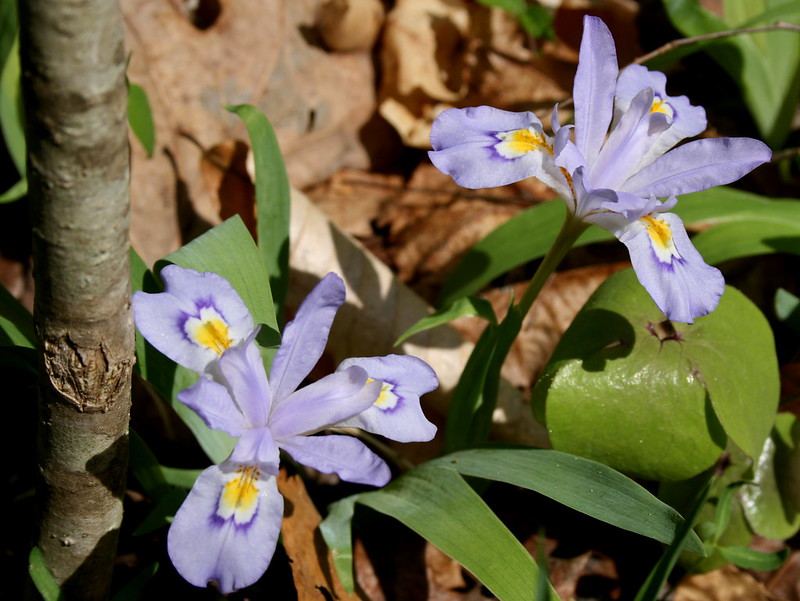
Photo Credit: OakleyOriginals / Flickr / CC BY 2.0
This Columbia native species is a woodland perennial that spreads by underground rhizomes and creates impressive clumps. It grows well in dappled shades and produces delicate lavender and white flowers that attract hummingbirds and bees.
The crested iris sprouts up to only 16 inches in height, at most. You can use this native flowering perennial as a ground cover in perennial borders or shady areas of rock gardens.
Plant type: Flower
Mature size: 4 to 16 inches tall
Duration: Perennial
Sunlight needs: Shade
Soil preferences: Well-draining and moist soil
Water needs: Medium
USDA hardiness zone: 3a – 8b
5. Goldenrod (Solidago spp)
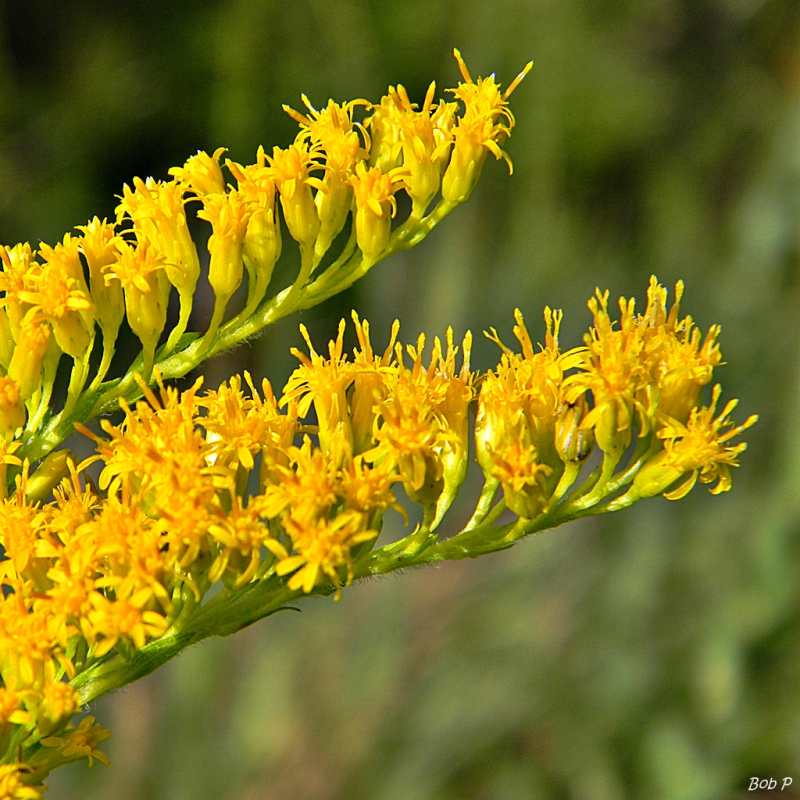
Photo Credit: Bob Peterson from North Palm Beach, Florida, Planet Earth! / Wikimedia Commons / CC BY-SA 2.0
Solidago is a herbaceous perennial from the aster family and produces bright yellow, small flowers in dense clusters. These clusters sit stop tall stems and keep your garden yellow from July through September. Goldenrod is vastly used for medicinal purposes and produces abundant nectar for butterflies, wasps, bees, and seeds for birds.
Goldenrod also neutralizes quickly so you might want to divide them to control the spread. This flowering native plant is also resistant to deer so you won’t have to worry about a ruined yard.
Plant type: Flower
Mature size: 2 to 6 feet tall
Duration: Perennial
Sunlight needs: Full, bright sun
Soil preferences: Will survive in dry soils
Water needs: Medium
USDA hardiness zone: 2a – 8b
6. Deciduous Azalea (Rhododendron austrinum)
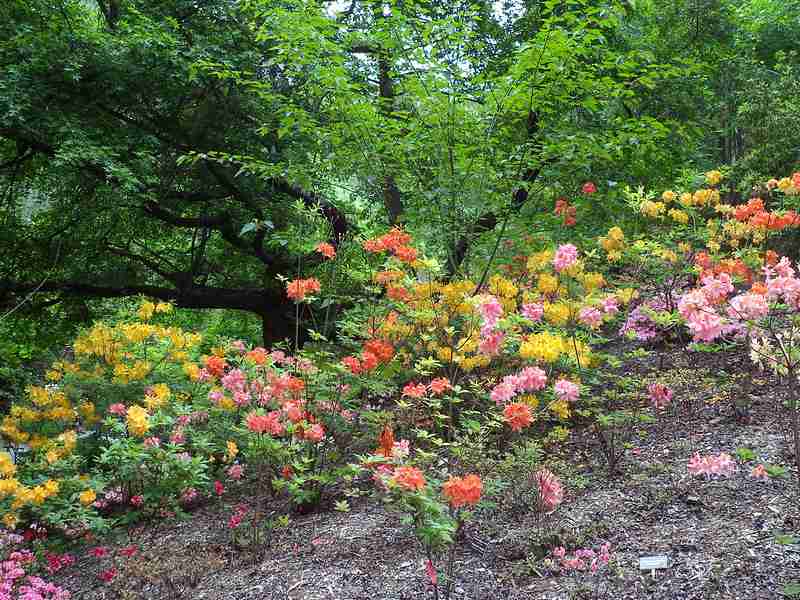
Photo Credit: denisbin / Flickr / CC BY-ND 2.0
This plant has over 13 deciduous species that are native to the U.S., one being exclusively found in South Carolina. The Azaleas bloom from early spring till mid-summer and spread white, pink, orange, or red, and sweet fragranced flowers.
As the name implies, deciduous azaleas have lots of leaves that change color as the temperature drops. You will have a variety of colors throughout the year in your garden from early spring to late autumn days.
Plant type: Shrub
Mature size: 2 to 15 feet tall, depending on the species
Duration: Perennial
Sunlight needs: Shade with partial sun
Soil preferences: Well-draining, acidic soil
Water needs: Medium once established
USDA hardiness zone: 7a – 9b, depending on the species
7. Devilwood Osmanthus (Cartrema americana)
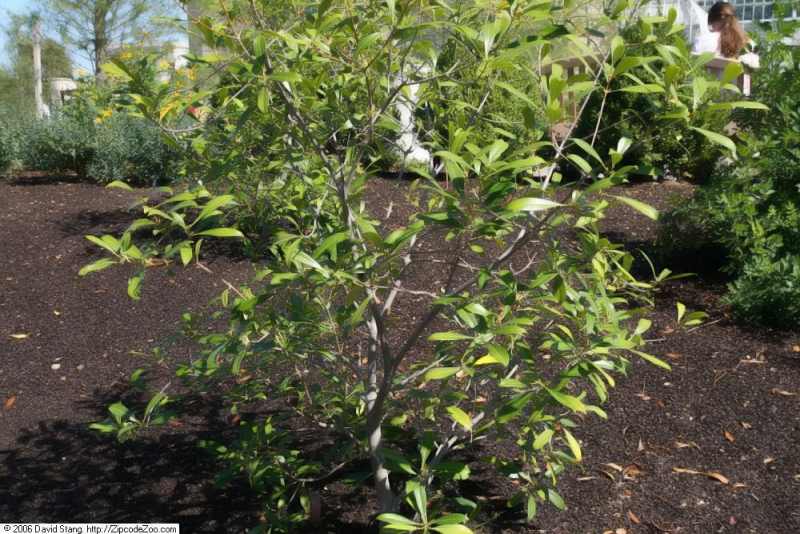
Photo Credit: Photo by David J. Stang / Wikimedia Commons / CC BY-SA 4.0
Cartrema americana, or the Ostmanthus americanus, is a shrub that may sometimes develop into a small tree, 13 to 23 feet tall. Devilwood bears small, white, and strongly fragranced flowers early in the spring. And when the plant is mature, it produces globose fruits with dark blue drupes that contain a single seed. Their sweet smell attracts songbirds, bees, and pollinators.
The evergreen devilwood shrub lasts year round with its small, urn-shaped white flowers maturing into dark blue drupes in the fall. The bark is finely scaly and gray-brown while the leaves have a rusty-colored underside and wavy margins. It’s easy to grow too, devilwood tolerates a range of light, wind, and soil conditions.
Plant type: Shrub or tree
Mature size: 15 to 20 feet tall
Duration: Perennial
Sunlight needs: Prefers partial shade
Soil preferences: Well-draining, moist soil
Water needs: Moderate
USDA hardiness zone: 6a – 9b
8. Fraser Magnolia (Magnolia fraseri)
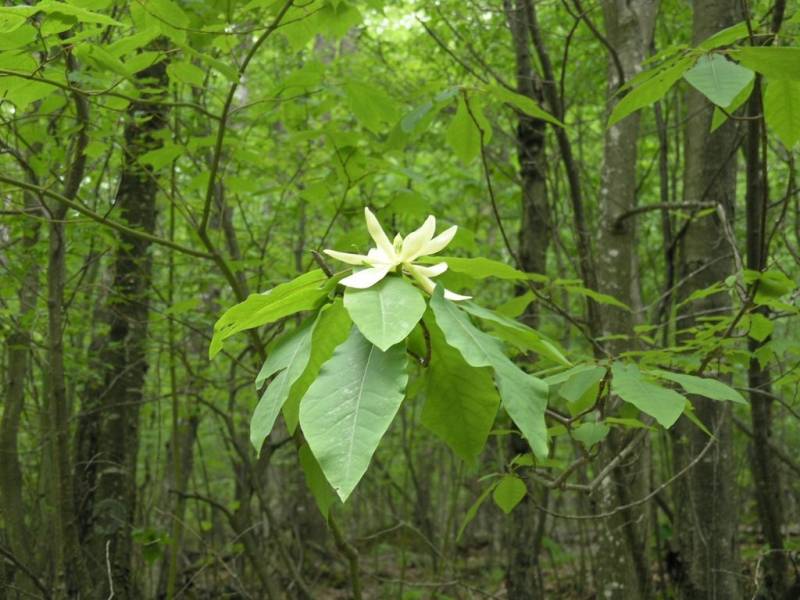
Photo Credit: Richtid / Wikimedia Commons / CC BY-SA 3.0
This deciduous tree is also referred to as mountain magnolia, mountain-oread, or the ear leaf cucumbertree. Fraser magnolia can grow quite tall, up to 40 feet, when fully mature and its snowy white flowers give off a sweet, pleasant fragrance.
This native plant blooms in late spring and early summer and typically contains just one or two seeds. You can spot a magnolia tree from afar with its large leaves, an open crown of spreading branches, and huge flowers. Its long leaves turn from green to yellow and then brown in the fall while the flowers serve as a food source for the wildlife at every stage.
Plant type: Flowering tree
Mature size: Up to 40 feet tall
Duration: Perennial
Sunlight needs: Full sun to partial shade
Soil preferences: Moist and well-draining soil
Water needs: Moderate
USDA hardiness zone: 6a – 9b
9. American Beautyberry (Callicarpa americana)
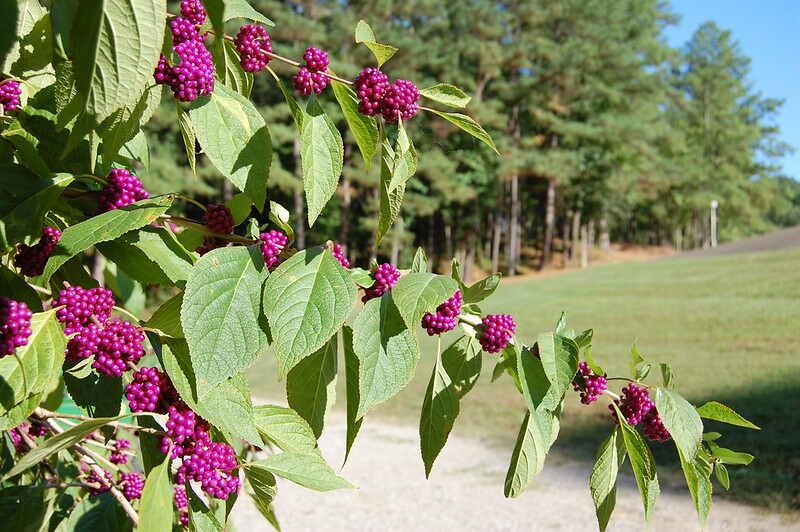
Photo Credit: Donald Lee Pardue / Flickr / CC BY 2.0
This native shrub will stand out in your Columbia yard with its distinctive yellow-green fall foliage and clusters of striking, glossy, purple fruit. These bright purple berries ripe late in June or July and make a favored food source for bobwhite and other berry-eating native birds.
The arching branches create a fountain-like shape, giving your landscape a unique edge. During spring, American beautyberry also produce balls of small pink flowers at each leaf node.
Plant type: Shrub
Mature size: 4 to 8 feet tall
Duration: Perennial
Sunlight needs: Full sun and partial shade
Soil preferences: Loam or sandy soil
Water needs: Low
USDA hardiness zone: 8a – 10b
10. Palmetto Palm (Sabal palmetto)
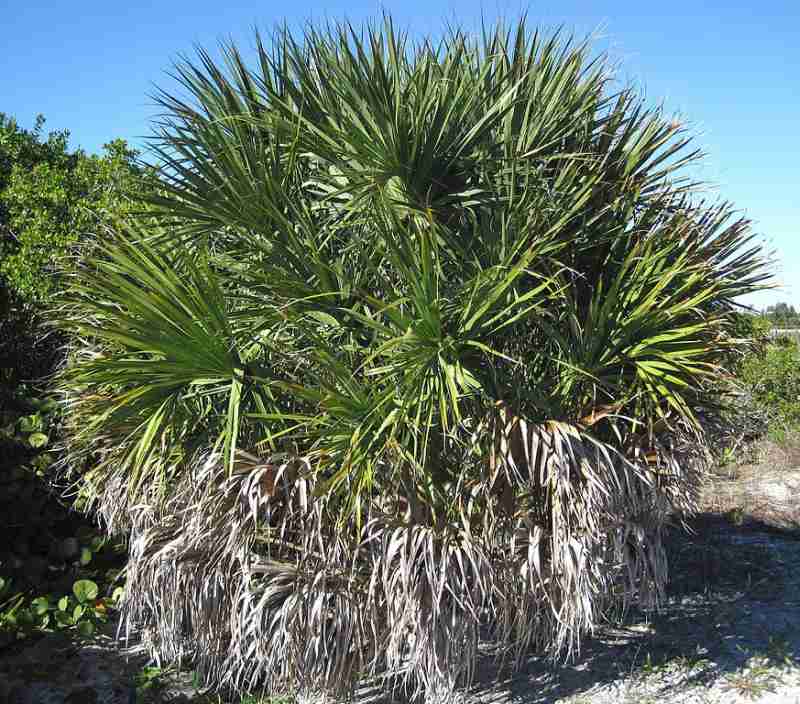
Photo Credit: James St. John / Wikimedia Commons / CC BY 2.0
South Carolina’s state tree, the Palmetto palm is a tall native tree that is a great option for you if you want some shade in your Columbia landscape. It has blue-green, fan-shaped leaves that offer a great nesting space for migrating birds and provide shade.
The best thing about palmetto palm trees is that you don’t have to worry about them freezing in the South Carolina cold. It’s a low-maintenance plant that blooms around June and produces nectar for honeybees.
Plant type: Palm
Mature size: Up to 100 feet tall
Duration: Perennial
Sunlight needs: Full sun to partial shade
Soil preferences: Loam or sandy soil
Water needs: Low
USDA hardiness zone: 8a – 11b
11. Foamflower (Tiarella cordifolia)
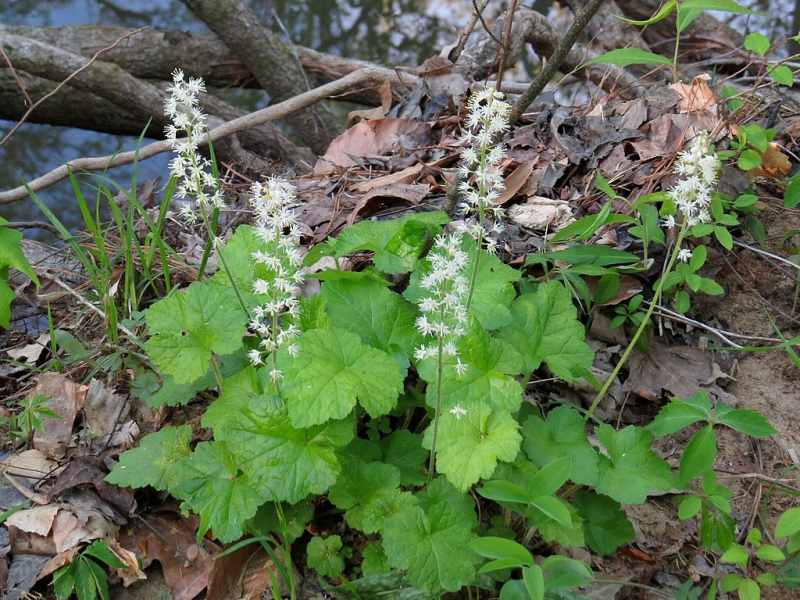
Photo Credit: Evan M. Raskin / Wikimedia Commons / CC BY 4.0
Tiarella cordifolia is a native perennial that is found all through Eastern North America and the East Coast of the United States. It’s also referred to as heart-leaved foamflower because of its unique, attractive foliage. It produces about 8-inch stalks and develops white, feathery flowers.
This plant prefers shade and will thrive on a lawn that gets dappled sunlight. It blooms early in the spring and continues till mid-spring before the flowers start fading. However, the foliage is evergreen and creates a pleasing visual.
Plant type: Flowering plant
Mature size: 8 to 16 inches
Duration: Perennial
Sunlight needs: Full sun to partial shade
Soil preferences: Loam or sandy soil
Water needs: Low
USDA hardiness zone: 3a – 8b
How to Choose the Best Natives for Your Columbia Landscape
Landscaping with native plants doesn’t automatically make it easier to maintain your Columbia landscape, you need to pick the right natives that go well with the soil, light, and wind exposure in your area.
Moreover, when choosing native plants for your garden you need to take the plant’s USDA Hardiness Zone range. This range will help you determine and narrow down the right plants for your yard. Columbia Hardiness Zone is 7a to 8b.
When planning your Columbia garden, aim to create a healthy ecosystem that benefits your plants, the winged visitors, small mammals, and the environment. Water, soil, wind, moisture, and the overall climate should sync with your plants. For more information, you can check South Carolina Native Plant Society.
Where to find native plants in Columbia
Native species shouldn’t be hard to spot around your neighborhood. Better yet, you may find some natives already sprouting up in your yard. Don’t pull them out if you see them, as it will disturb the natural habitat. Instead, try to build your lawn around them.
You can also buy from the local selection of natives at nurseries such as Humble Roots Nursery, Native Plants Garden Center, and Alex’s Nursery, or order from Carolina native nursery.
The Final Word
And when you’ve chosen and brought home your new native plants, plan the landscape around them and spruce up other parts of your garden to create a final look. Take a look at Wikilawn’s detailed guide on the best grass types for Columbia to see what grass bed should be planted with your natives. If you need help with setting up or regular maintenance of your Columbia lawn, hire one of our pros who will keep your yard and native plants happy.
Main Photo Credit: Wallpaperflare